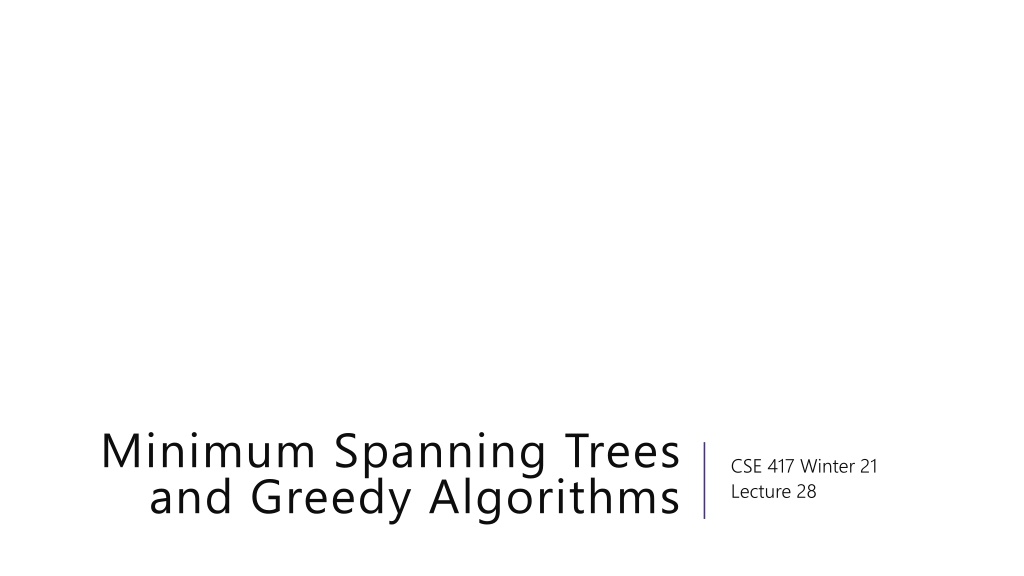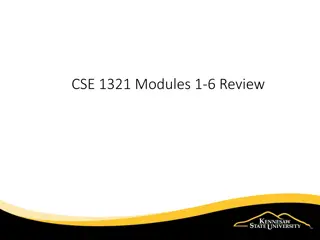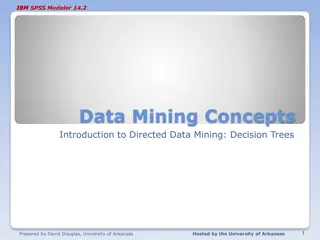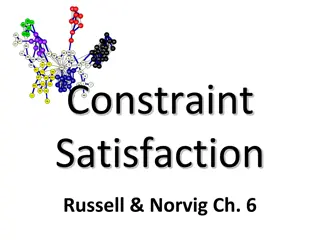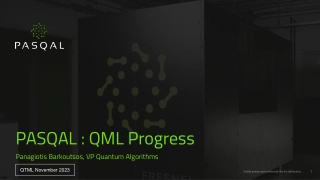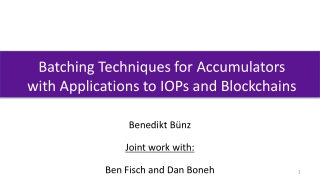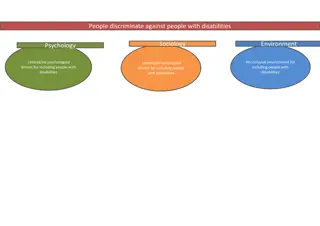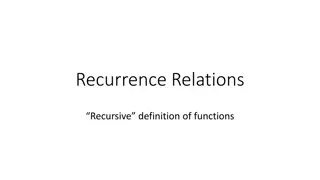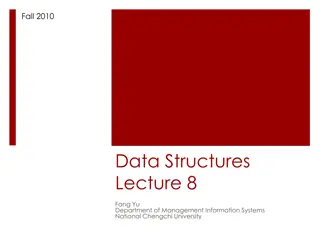Understanding Greedy Algorithms and Minimum Spanning Trees
Greedy algorithms build solutions by considering objects one at a time using simple rules, while Minimum Spanning Trees find the most cost-effective way to connect vertices in a weighted graph. Greedy algorithms can be powerful, but their correctness relies on subtle proofs and careful implementation. The minimum spanning tree problem aims to find a connected set of edges with the least total weight to cover all vertices in a graph efficiently.
Download Presentation
Please find below an Image/Link to download the presentation.
The content on the website is provided AS IS for your information and personal use only. It may not be sold, licensed, or shared on other websites without obtaining consent from the author. Download presentation by click this link. If you encounter any issues during the download, it is possible that the publisher has removed the file from their server.
Presentation Transcript
Minimum Spanning Trees and Greedy Algorithms CSE 417 Winter 21 Lecture 28
Greedy Algorithms What s a greedy algorithm? An algorithm that builds a solution by: Considering objects one at a time, in some order Using a simple rule simple rule to decide on each object. Never goes back and changes its mind. order.
Greedy Algorithms PROS Simple CONS Rarely correct Often multiple equally intuitive options Need to focus on proofs! Hard to prove correct Usually need a fancy structural result Or complicated proof by contradiction
Your Takeaways Greedy algorithms are great when they work. But it s hard to tell when they work the proofs are subtle. And you can often invent 2-3 different greedy algorithms; it s rare that 1 works, extremely rare that all would work. So you have to be EXTREMELY careful. This will be a crash course in greedy algorithms. If you have a lot of experience with proofs, I ll be highlighting the general patterns in the proofs. If you don t, just appreciate the proofs are hard, and promise not to write a greedy algorithm unless someone has proven it correct.
Three Proof Techniques Structural result the best solution must algorithm produces something that looks like this. Greedy stays ahead at every step of the algorithm, the greedy algorithm is at least as good as anything else could be. Exchange Contradiction proof, suppose we swapped in an element from the (hypothetical) better solution. must look like this, and the Where to start? With some greedy algorithms you ve already seen. Minimum Spanning Trees!
Minimum Spanning Trees It s the 1920 s. Your friend at the electric company needs to choose where to build wires to connect all these cities to the plant. B 6 3 E 2 1 C 10 A 9 5 7 4 D 8 She knows how much it would cost to lay electric wires between any pair of cities, and wants the cheapest way to make sure electricity from the plant to every city.
Minimum Spanning Trees What do we need? A set of edges such that: Every vertex touches at least one of the edges. (the edges span The graph on just those edges is connected The minimum weight set of edges that meet those conditions. span the graph) connected. Minimum Spanning Tree Problem Given: an undirected, weighted graph G Find: A minimum-weight set of edges such that you can get from any vertex of G to any other on only those edges.
Greedy MST algorithms You ve seen two algorithms for MSTs Kruskal s Algorithm Kruskal s Algorithm: Order Order: Sort the edges in increasing weight order Rule: Rule: If connect new vertices (doesn t form a cycle), add the edge. Prim s Algorithm: Prim s Algorithm: Order: Order: lightest weight edge that adds a new vertex to our current component Rule: Rule: Just add it!
Kruskals Algorithm KruskalMST(Graph G) initialize each vertex to be its own component sort the edges by weight foreach(edge (u, v) in sorted order){ if(u and v are in different components){ add (u,v) to the MST Update u and v to be in the same component } }
Try It Out B 6 3 E KruskalMST(Graph G) initialize each vertex to be its own component sort the edges by weight foreach(edge (u, v) in sorted order){ if(u and v are in different components){ add (u,v) to the MST Update u and v to be in the same component } } Edge Include? Reason (A,C) (C,E) (A,B) (A,D) (C,D) 2 1 C A 10 9 5 7 4 D F 8 Edge (cont.) (B,F) (D,E) (D,F) (E,F) (C,F) Inc? Reason
Try It Out B 6 3 E 2 KruskalMST(Graph G) initialize each vertex to be its own component sort the edges by weight foreach(edge (u, v) in sorted order){ if(u and v are in different components){ add (u,v) to the MST Update u and v to be in the same component } } Edge Include? Reason (A,C) Yes (C,E) Yes (A,B) Yes (A,D) Yes (C,D) No 1 C A 10 9 5 7 4 D F 8 Edge (cont.) (B,F) (D,E) (D,F) (E,F) (C,F) Inc? Yes No No No No Reason Cycle A,C,E,D,A Cycle A,D,F,B,A Cycle A,C,E,F,D,A Cycle C,A,B,F,C Cycle A,C,D,A
Code PrimMST(Graph G) initialize costToAdd to mark source as costToAdd 0 mark all vertices unprocessed, mark source as processed foreach(edge (source, v) ) { v.costToAdd = weight(source,v) v.bestEdge = (source,v) } while(there are unprocessed vertices){ let u be the cheapest to add unprocessed vertex add u.bestEdge to spanning tree foreach(edge (u,v) leaving u){ if(weight(u,v) < v.costToAdd AND v not processed){ v.costToAdd = weight(u,v) v.bestEdge = (u,v) } } mark u as processed }
50 G 6 Try it Out B E 2 3 4 C 5 PrimMST(Graph G) initialize costToAdd to mark source as costToAdd 0 mark all vertices unprocessed mark source as processed foreach(edge (source, v) ) { v.costToAdd = weight(source,v) v.bestEdge = (source,v) } while(there are unprocessed vertices) { let u be the cheapest unprocessed vertex add u.bestEdge to spanning tree foreach(edge (u,v) leaving u){ if(weight(u,v) < v.costToAdd AND v not processed){ v.costToAdd = weight(u,v) v.bestEdge = (u,v) } } mark u as processed } A 9 2 7 7 F D 8 Vertex costToAdd Best Edge Processed A B C D E F G
50 G 6 Try it Out B E 2 3 4 C 5 PrimMST(Graph G) initialize costToAdd to mark source as costToAdd 0 mark all vertices unprocessed mark source as processed foreach(edge (source, v) ) { v.costToAdd = weight(source,v) v.bestEdge = (source,v) } while(there are unprocessed vertices) { let u be the cheapest unprocessed vertex add u.bestEdge to spanning tree foreach(edge (u,v) leaving u){ if(weight(u,v) < v.costToAdd AND v not processed){ v.costToAdd = weight(u,v) v.bestEdge = (u,v) } } mark u as processed } A 9 2 7 7 F D 8 Vertex costToAdd Best Edge Processed A -- -- B 2 (A,B) C 4 (A,C) D 7 2 (A,D)(C,D) E 6 5 (B,E)(C,E) F 3 (B,F) G 50 (B,G) Yes Yes Yes Yes Yes Yes Yes
Correctness You re already familiar with the algorithms. We ll use this problem to practice the proof techniques. We ll do both structural and exchange structural and exchange
Structural Proof For simplicity assume all edge weights are distinct and that there is only one minimum spanning tree. Structural result the best solution must algorithm produces something that looks like this. must look like this, and the Example: every spanning tree has ? 1 edges. So we better have our algorithm produce ? 1 edges. Is that enough? No! Lots of different trees (including non minimum ones) have ? 1 edges. Need to say which edges are in the tree.
Safe Edge A cut ?,? ? is a split of the vertices into a subset ? and the remaining vertices ? ?. 50 G 6 B 3 E 2 5 4 C A 9 2 7 7 F D ? = {?,?,?,?} 8 Edges in red span or cross the cut (go from ? to ? ?).
Safe Edge Call an edge, ?, a safe edge if there is some cut (?,? ?) where ? is the minimum edge spanning that cut (C,D) is a safe edge 50 G 50 G 6 B 3 6 E B 3 2 E 2 5 4 C 5 A 4 C 9 A 2 9 7 2 7 7 F D 7 F D 8 8 (A,B) is a safe edge
MSTs and Safe Edges Every safe edge is in the MST. Proof: Proof: Suppose, for the sake of contradiction, that ? = (?,?) is a safe edge, but not in the MST. Let (?,? ?) be a cut where ? is the minimum edge spanning (?,? ?). Let ? be the MST. The MST has (at least one) an edge ? that crosses the cut (since we can get from ? to ? in ? ) ? ? ? ? ?
MSTs and Safe Edges Add ?=(?,?) to ? . The new graph has a cycle including both ? and ? , The cycle exists because ? and ? were connected to each other in ? (since it was a spanning tree). Consider ? , which is ? with ? added and ? removed. ? ? ? ? ?
MSTs and Safe Edges Consider ? , which is ? with ? added and ? removed. ? crosses: if the path from ? to ? in ? didn t use ? it still exists. If it did use ? , follow along the path to ? , along the cycle through ? to the other side. And it s a tree (it has ? 1 edges). What s its weight? Less than ? -- ? was the lightest edge spanning (?,? ?). That s a contradiction! ? was the minimum spanning tree. ? ? ? ? ?
Prims only adds safe edges When we add an edge, we add the minimum weight one among those that span from the already connected vertices to the not-yet-connected ones. That s a cut! And that cut shows the edge we added is safe! So we only add safe edges and we added all the edges we need (every MST has ? 1 edges)
What about Kruskals? Exchange argument: General outline: Suppose, you didn t find the best one. Suppose there s a better MST Then there s something in the algorithm s solution that doesn t match OPT. (an edge that isn t a safe edge/that s heavier than it needs to be) Swap (exchange exchange) them, and finish the proof (arrive at a contradiction or show that your solution is equal in quality)!
Kruskals Proof Suppose, for the sake of contradiction, ??, the tree found by Kruskal s algorithm isn t a minimum spanning tree. Let ? be the true minimum spanning tree. Let ? = (?,?) be the lightest edge in ?? but not in ? . Add ? to ? , and we will create a cycle (because there is a way to get from ? to ? in ???? by it being a spanning tree). ? is not the heaviest edge on the cycle. Anything lighter than ? is already in ??, and we put ? in ??so it didn t create a cycle there (since we check for cycles before adding it). That means there is an edge on the cycle heavier than ?. Delete that edge, and call the resulting graph ? . Observe that ? is a spanning tree (it has ? 1 edges, and spans all the same vertices ? did since we deleted an edge from a cycle). But it has less weight than ? which was supposed to be the MST. That s a contradiction!
HeyWait a minute Those arguments were pretty similar. They both used an exchange idea. The boundaries between the proof principles are a little blurry They re meant to be useful for you for thinking about where to start with a proof, not be a beautiful taxonomy of exactly what technique is which.
Trip Planning Your goal is to follow a pre-set route from New York to Los Angeles. You can drive 500 miles in a day, but you need to make sure you can stop at a hotel every night (all possibilities premarked on your map) You d like to stop for the fewest number of nights possible what should you plan? Greedy: Go as far as you can every night. Is greedy optimal? Or is there some reason to stop short that might let you go further the next night?
Trip Planning Greedy works! Because greedy stays ahead Let ?? be the hotel you stop at on night ? in the greedy algorithm. Let ???? be the hotel you stop at in the optimal plan (the fewest nights plan). Claim: ?? is always at least as far along as ????. Intuition: Intuition: they start at the same point before day 1, and greedy goes as far as possible, so is ahead after day 1. And if greedy is ahead at the start of the day, it will continue to be ahead at the end of the day (since it goes as far as possible, and the distance you can go doesn t depend on where you start). Therefore it s always ahead. And so it uses at most the same number of days as all other solutions.
Induction A formal version of the intuition on the last slide is a proof by induction. The next two slides contain the formal version if you re curious
Trip Planning Greedy works! Because greedy stays ahead Let ?? be the hotel you stop at on night ? in the greedy algorithm. Let ???? be the hotel you stop at in the optimal plan (the fewest nights plan). Claim: ?? is always at least as far along as ????. Base Case: ? = 1, OPT and the algorithm choose between the same set of hotels (all at most 500 miles from the start), ?? is the farthest of those by the algorithm definition, so ?? is at least as far as ????.
Trip Planning Inductive Hypothesis: Suppose through the first ? hotels, ?? is farther along than ????. Inductive Step: When we select ??+1, we can choose any hotel within 500 miles of ??, since ?? is at least as far along as ???? everything less than 500 miles after ???? is also less than 500 miles after ??. Since we take the farthest along hotel, ??+1is at least as far along as ????+1.
Change-Making Suppose you need to make change with the fewest number of coins possible. Greedy algorithm: Take the biggest coin less than the change remaining. Is the greedy algorithm optimal if you have 1 cent coins, 10 cent coins, and 15 cent coins?
Change-Making The greedy algorithm doesn t always work! We made you explain this on the homework problem during the DP section. But there are times where it does For standard US coinage, the greedy algorithm works And it also always works if your coins always exactly double in value. Another reason to be very careful with greedy algorithms! Also a good example of how you can sometimes avoid greedy if you can t figure out a proof maybe there s a way to write a DP instead!
Interval Scheduling You have a single processor, and a set of jobs with fixed start and end times. Your goal is to maximize the number of jobs you can process. I.e. choose the maximum number of non-overlapping intervals.
Interval Scheduling You have a single processor, and a set of jobs with fixed start and end times. Your goal is to maximize the number of jobs you can process. I.e. choose the maximum number of non-overlapping intervals. 3 non-overlapping intervals
Interval Scheduling You have a single processor, and a set of jobs with fixed start and end times. Your goal is to maximize the number of jobs you can process. I.e. choose the maximum number of non-overlapping intervals. 3 other non- overlapping intervals
Interval Scheduling You have a single processor, and a set of jobs with fixed start and end times. Your goal is to maximize the number of jobs you can process. I.e. choose the maximum number of non-overlapping intervals. OPT is 3 there is no way to have 4 non-overlapping intervals; both the red and purple solutions are equally good.
Greedy Ideas To specify a greedy algorithm, we need to: Order the elements (intervals) Choose a rule for deciding whether to add. Rule: Rule: Add interval as long as it doesn t overlap with those we ve already selected. What ordering should we use? Think of at least two at least two orderings you think might work.
Greedy Algorithm Some possibilities Earliest end time (add if no overlap with previous selected) Latest end time Earliest start time Latest start time Shortest interval Fewest overlaps (with remaining intervals)
Greedy That list slide is the real difficulty with greedy algorithms. All of those look at least somewhat plausible at first glance. With MSTs that was fine those ideas all worked! It s not fine here. They don t all work. As a first step try to find counter-examples to narrow down
Greedy Algorithm Earliest end time Latest end time Earliest start time Latest start time Shortest interval Fewest overlaps (with remaining intervals)
Take Earliest Start Time Counter Example Algorithm finds Optimum Taking the one with the earliest start time doesn t give us the best answer.
Shortest Interval Algorithm finds Optimum Taking the shortest interval first doesn t give us the best answer
Greedy Algorithm Earliest end time Latest end time Earliest start time Latest start time Shortest interval Fewest overlaps (with remaining intervals)
Earliest End Time Intuition: If ? has the earliest end time, and ? overlaps with ? and ? then ? and ? also overlap. Why? If ? and ?overlap, then both are active at the instant before ? ends (otherwise ? would have an earlier end time). Otherwise ? would have an earlier end time than ?! By the same reasoning, ?is also active the instant before ? ends. So ? and ? also overlap with each other.
Earliest End Time Can you prove it correct? Do you want to use Structural Result Exchange Argument Greedy Stays Ahead
Exchange Argument Let ? = ?1,?2, ,?? be the set of intervals selected by the greedy algorithm, ordered by endtime OPT= ?1,?2, ,? be the maximum set of intervals, ordered by endtime. Our goal will be to exchange to show ? has at least as many elements as OPT. Let ??,?? be the first two elements where ?? and ??aren t the same. Since ?? 1 and ?? 1 are the same, neither ?? nor ?? overlaps with any of ?1, ,?? 1. And by the greedy choice, ?? ends no later than ?? so ??doesn t overlap with ??+1. So we can exchange ?? into OPT, replacing ?? and still have OPT be valid.
